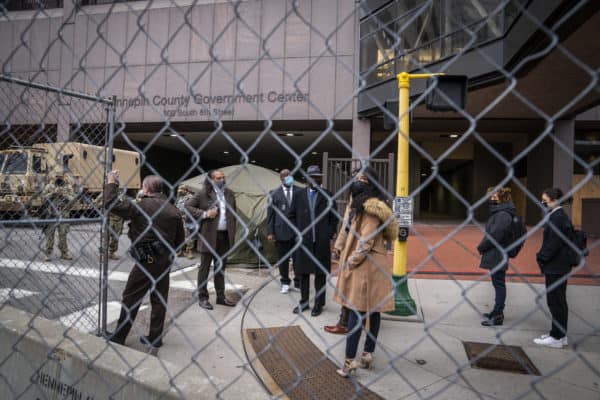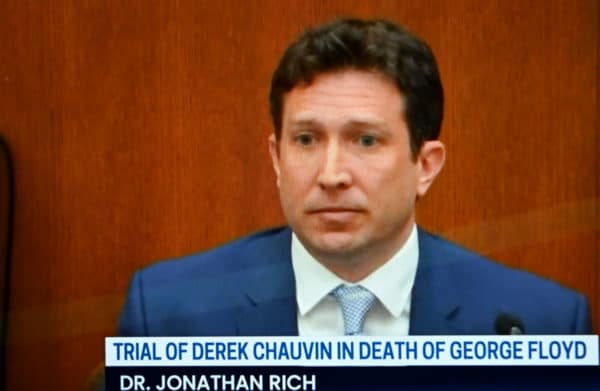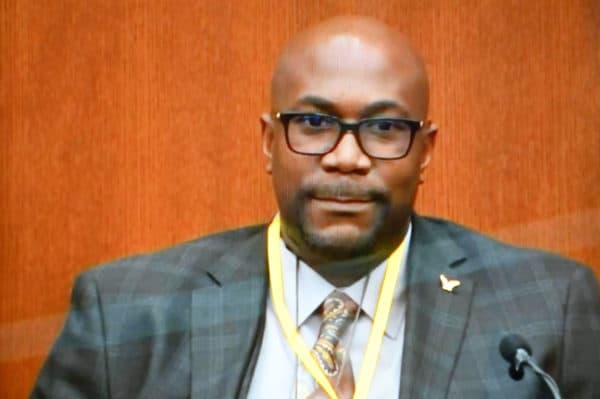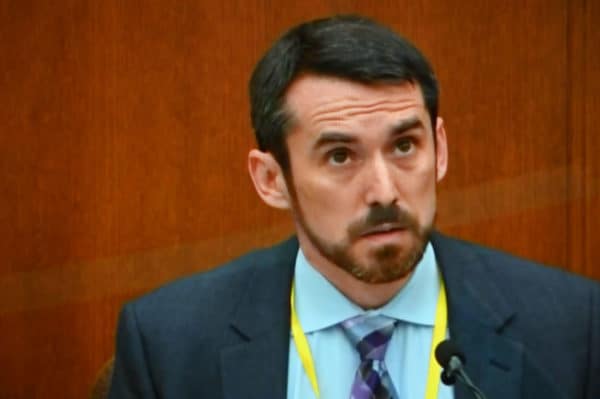The Derek Chauvin Trial — Day 11
Anastasia Katz, American Renaissance, April 13, 2021

April 12, 2021: The family of George Floyd and their supporters wait after going through security to enter the Hennepin County Government Center. This is the third week of testimony in the Derek Chauvin trial. (Credit Image: © TNS via ZUMA Wire)
Editor’s Note: See our coverage of the first day of the trial here, the second day here, and the third day here, the fourth day here, the fifth day here, the sixth day here, the seventh day here, the eighth day here, the ninth day here, and the tenth day here.
Court began with discussions outside the presence of the jury. Derek Chauvin’s lawyer, Eric Nelson, objecting to the prosecution’s plan to call another use-of-force expert. He said it would only be repetition of what other witnesses have said. Earlier, Judge Peter Cahill cautioned prosecutors about “cumulative” witnesses, and said he would not let them bring every cop in and ask, “What would you do differently?” The judge said this again, but decided to allow the witness, though with limits on the questions.
There was also a discussion about Morries Hall’s testimony. Mr. Hall was in the passenger seat of George Floyd’s car when Floyd was arrested. Those of you who saw the video may remember that he was dressed in a red hat and red pants. Mr. Hall’s lawyer said that Mr. Hall wanted to take the fifth because testifying could open him to charges. Floyd’s girlfriend testified earlier that Floyd often bought illegal drugs from Mr. Hall, and if Floyd died of an overdose, he could be charged with third-degree murder. Mr. Hall gave two different fake names to officers when Floyd was arrested, and he fled Minneapolis. He was caught in Texas.
Mr. Nelson said he would limit questions to what happened in the car before police arrived. If Mr. Hall would not testify at all, Mr. Nelson would show a video of Mr. Hall being interviewed by an agent from the Bureau of Criminal Apprehension (BCA). Judge Cahill said he would rule on this question at 1 PM.
The lawyers also discussed “spark of life” witnesses, who would talk about Floyd and humanize him for the jury. Prosecutor Matthew Frank said that this would include photos at various stages of Floyd’s life. Mr. Nelson warned that if these witnesses testify, it would be grounds to call witnesses to talk against Floyd’s character. Judge Cahill said, “I’m not allowing a lot of past that would amount to character evidence . . . . As soon as you start getting into propensity for violence or propensity for peacefulness, then we’re getting into character evidence, and that does open the door for the defense to cross-examine about his character for peacefulness.”
The judge said he would allow photos and descriptions of Floyd’s upbringing, but he told the prosecution to keep it brief.
Next, Mr. Nelson requested sequestration of the jury, in light of the police shooting from the previous night (Sunday, April 11th) that resulted in rioting. One of the jurors lives in the city where the shooting took place. Mr. Nelson wanted the judge to resume voir dire with the jurors to find out if they could still be impartial.
Judge Cahill decided not to sequester the jury, because the rioting was not because of a court verdict. He also said it would “just annoy” the jury. During jury selection, all of the jurors worried about what would happen if they acquitted Mr. Chauvin.
When the jury came in, the state called Dr. Jonathan Rich, a cardiologist, who specializes in heart failure and transplants. He works with Intensive Care Unit patients who often have low oxygen and need ventilators. Sometimes they die. Dr. Rich was not paid for reviewing evidence, but said that he would get $1,200 per day for testifying.

April 12, 2021, Minneapolis, Minnesota: Dr. Jonathan Rich, Cardiologist, testifies during the trial of former Minneapolis police officer Derek Chauvin. (Credit Image: © Pool Video Via Court Tv via ZUMA Wire)
Asked about Floyd’s cause of death, Dr. Rich said, “Mr. George Floyd died from cardiopulmonary arrest. It was caused by low oxygen levels, and those low oxygen levels were induced by the prone restraint and positional asphyxiation that he was subjected to.”
He added: “After reviewing all of the facts and evidence of the case, I can state with a high degree of medical certainty that George Floyd did not die from a primary cardiac event, and he did not die from a drug overdose.” “Primary” means something happens in the heart itself, such as a heart attack, when an artery is blocked, or if the heart goes into sudden arrhythmia.
Dr. Rich said the medical records showed hypertension (high blood pressure), drug taking, and anxiety. He did not see anything in the records to show that Floyd may have had heart problems. The doctor thought Floyd had a “strong” heart because of his high blood pressure. He said high blood pressure is bad for you over the long run, because the heart eventually “tires out.” However, patients with high blood pressure never need a heart transplant, because their hearts are strong enough to keep working. Floyd had high blood pressure, with a recorded top (systolic) pressure of over 200. Floyd was prescribed medicine for high blood pressure, but the doctor didn’t know if Floyd took it.
Dr. Rich said that in the videos, Floyd never complained of chest pain or palpitations. He also said that when Floyd got out of his car, he did not seem to be suffering from any medical problems. When Floyd was asked to sit in the police car, and when he was on the ground, the doctor did not see anything that suggested there might be something wrong with his heart. Floyd did not say he was dizzy and did not seem to be dizzy, but when he was on the ground he was “restrained in a life threatening manner.”
The doctor said that the most common fatal arrhythmia is ventricular fibrillation (VF), which leads to sudden loss of consciousness, with the patient “keeling over” and dying. The doctor said Floyd passed out gradually.
According to the paramedics and hospital staff who treated Floyd, he had pulseless electrical activity (PEA). Dr. Rich described PEA as a “chaotic heart rhythm” that shows up on a heart monitor. He said the most common cause for PEA is hypoxia (low oxygen). Prosecutor Jerry Blackwell asked the doctor if Floyd could have had a “silent heart attack.” Dr. Rich says silent heart attacks are most common in patients with diabetes, and Floyd was not diabetic. Dr. Rich said that putting Floyd on his side would have saved his life, and that giving him CPR as soon as his heart stopped would also have saved his life.
On cross-exam, Mr. Nelson asked Dr. Rich if, hypothetically, a patient with a 90 percent artery blockage can die of a heart attack and the doctor agreed. He agreed that Floyd had heart disease, but repeated that he did not think Floyd had a heart attack. He said his body had created extra blood vessels to compensate for the blockage, and added that a patient is more likely to have a heart attack with less than 90 percent blockage.
Dr. Rich agreed that there is no safe amount of any illicit drug, that methamphetamine constricts blood vessels, and Floyd’s prolonged meth use contributed to heart disease. Mr. Nelson asked, “Would you recommend that someone with Floyd’s extent of heart disease use methamphetamine?” Dr. Rich said he would never recommend drugs “off the street.”
Mr. Nelson asked Dr. Rich if Floyd would have survived if he had gotten into the squad car. The doctor said that Floyd would have survived if he had not been restrained. Nelson repeated the question, and Dr. Rich said, “I think my answer remains the same.”
Mr. Nelson asked if the prone position is inherently dangerous. The doctor said that for the average person, it is. Dr. Rich said that patients in the ICU are put face down when they are in severe respiratory distress, but they are on a respirator and are sedated. Mr. Nelson asked if all of Floyd’s problems combined could cause death without the restraint, and Dr. Rich said, “No.”
When court resumed after lunch, Judge Cahill ruled that the video of Morries Hall talking to BCA agents would not be admissible. This was a blow to the defense because Mr. Hall says that Floyd was falling asleep in the car. As many doctors have already testified, sleepiness is a symptom of fentanyl overdose.
The first witness after lunch was Philonise Floyd, age 39, George Floyd’s younger brother with “spark of life” testimony. Minnesota is unusual; most states allow this kind of testimony only at the sentencing stage. Philonise remembered playing video games with George and that his big brother was always measuring his height because he wanted to grow tall and be an athlete. He was shown a photo of Mrs. Floyd holding her son when he was a baby, and Philonise teared up, saying he missed them both so much.

April 12, 2021, Minneapolis, Minnesota: Philonese Floyd, brother of George Floyd, testifies during the trial of former Minneapolis police officer Derek Chauvin. (Credit Image: © Pool Video Via Court Tv via ZUMA Wire)
Philonese said George talked to his mother on the phone the day before she died, but could not come say goodbye in person. Philonese said that during the funeral in 2018, his older brother cried and said “Mama” several times. That was the last time Philonise Floyd saw his brother.
The prosecution’s last witness was Seth Stoughton, an associate professor at South Carolina University Law School, who has written a book about police misconduct. He was a police officer for fewer than five years before becoming an academic, and he said that he had had to cuff suspects who were resisting him. The prosecution is paying him $295 an hour.
He started with a discussion of Graham v. Connor, a Supreme Court case that defines when force is justified, according to:
- The severity of the crime.
- Whether the suspect is an immediate threat to officers or others.
- Whether the suspect is resisting arrest or trying to get away.
The professor said that the size of a person and recent drug use are “relevant considerations” but not a “threat,” while trying to get away from police is a threat. He said that an officer must consider the foreseeable effect of force, not what actually happened. When an officer fires a weapon, it is foreseeable that the person he shoots at will be killed, even if the officer misses. Prof. Stoughton also emphasized that force must be “appropriate, proportional and reasonable.”
The prosecution showed bits of video for Professor Stoughton to comment on. When a segment showed Floyd struggling with the officers as he was in the car and refusing to sit, Prof. Stoughton said, “This does not appear to be active aggression in the sense that Mr. Floyd does not appear to have the intention to assault or attack the officers.”

April 12, 2021, Minneapolis, Minnesota: Seth Stoughton, University of South Carolina Law Professor, testifies during the trial of former Minneapolis police officer Derek Chauvin. (Credit Image: © Pool Video Via Court Tv via ZUMA Wire)
In one segment, Officer Kueng checks Floyd’s pulse and says there is no pulse. The professor said that once Floyd was non-responsive, use of force was not needed and was having a bad effect on Floyd’s health.
He said it was not necessary to put Floyd in the prone position, which limits breathing. Prof. Stoughton said that the officers talked about drugs being found and that Floyd was probably under the influence. He said they should have known that being under the influence would make it harder to breathe. He said that after Floyd said he couldn’t breathe, a reasonable officer should have known from the tone of Floyd’s voice, that he was suffering.
After playing a video that showed Officer Thao talking to bystanders, the professor argued that what he said — “This is why you don’t do drugs, kids” — showed that the officer did not think the bystanders were a threat.
Another video showed the crowd shouting angrily as some yelled, “Don’t you touch me!” The professor said this was after the paramedics took Floyd away, and that there was no threat to officers while Floyd was being restrained. He said that the bystanders went back on the sidewalk when Officer Thao told them to.
The professor said unreasonable force began when Mr. Chauvin put his knee on Floyd and ended when he took it off. He said that no reasonable police officer would believe this was reasonable.
On cross-examination, Mr. Nelson got Professor Stoughton to agree that there is more to Graham v. Connor than the three considerations mentioned above, and that an officer must consider the “totality of the circumstances.” He asked if a “reasonable police officer” is entitled to rely on his training. The professor said he is not looking at whether the officer is using his training; he is looking at what is generally accepted.
Mr. Nelson asked, “If someone says, ‘I’m going to cooperate! I’m going to cooperate!’ . . . but their actions are not cooperative, what is an officer supposed to do? Just automatically believe that at some time they’re going to cooperate?” Professor Stoughton said, “No, I don’t think an officer has to assume that person, at some future point, will comply.”
Mr. Nelson asked the professor if he agreed that a suspect should not get to decide whether he will sit on the ground or in the squad car. Professor Stoughton stammered, but then said, “Yes.”
Professor Stoughton insisted that it was unreasonable to put Floyd into the prone position. Mr. Nelson referred to an article Professor Stoughton wrote that was published in The Washington Post on May 29, 2020. He quoted: “Officers might need to hold someone down in the prone position, but they should do so by putting their shin across the subject’s upper back, not the neck.” Professor Stoughton explained that he had written that only four days after Floyd’s death.
Mr. Nelson asked the professor if Mr. Chauvin’s knee had been on George Floyd’s neck for the entire nine minutes and 29 seconds. He said that was “irrelevant;” the knee should have never been there.
Mr. Nelson asked if a reasonable police officer would know that he was being videoed; Prof. Stoughton agreed. He also agreed that use of force is not very pretty, and that something that looks bad may not be unlawful.
Mr. Nelson mentioned that at one point Officer Thomas Lane had said, “Jesus Christ.” The professor said that was because Floyd had smelly feet.
When Mr. Nelson asked about the crowd that gathered, Professor Stoughton said that 10 to 15 people is not a “crowd.” Cross-examination ended with Professor Stoughton agreeing that if Mr. Chauvin’s knee was on the trapezius muscle, that was not deadly force
Judge Cahill informed the jury that this was the last witness for the prosecution and they would hear from defense witnesses next. He told them closing arguments should be on Monday. He also told them that they should bring a packed suitcase on Monday, because they will be sequestered for deliberation.















